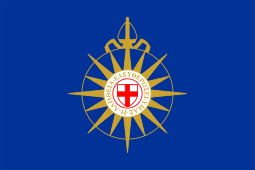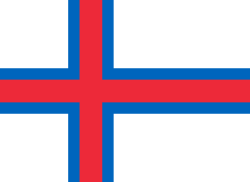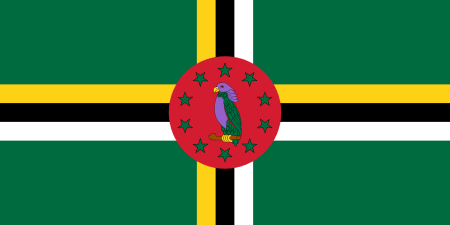Christian Flag

The Christian Flag is a flag designed in the early 20th century to represent all of Christianity and Christendom,[1] and has been most popular among Protestant churches in North America, Africa and Latin America.[2] The flag has a white field, with a red Latin cross inside a blue canton. The shade of red on the cross symbolizes the blood that Jesus shed on Calvary.[3] The blue represents the waters of baptism as well as the faithfulness of Jesus.[4] The white represents Jesus' purity.[5] In conventional vexillology, a white flag is linked to surrender, a reference to the Biblical description of Jesus' non-violence and surrender to God.[6] The dimensions of the flag and canton have no official specifications.
Origins

The Christian Flag was first conceived on September 26, 1897, at Brighton Chapel on Coney Island in Brooklyn, New York in the United States. The superintendent of a Sunday school, Charles C. Overton, gave an impromptu lecture to the gathered students, because the scheduled speaker had failed to arrive for the event. He gave a speech asking the students what a flag representing Christianity would look like.[7] Overton thought about his improvised speech for many years afterward. In 1907, he and Ralph Diffendorfer, secretary of the Methodist Young People's Missionary Movement, designed and began promoting the flag.[8] With regard to the Christian symbolism of the Christian Flag:
The ground is white, representing peace, purity and innocence. In the upper corner is a blue square, the color of the unclouded sky, emblematic of heaven, the home of the Christian; also a symbol of faith and trust. in the center of the blue is the cross, the ensign and chosen symbol of Christianity: the cross is red, typical of Christ's blood.[7]
The ecumenical Christian organization, Federal Council of Churches, now succeeded by the National Council of Churches and Christian Churches Together, adopted the flag on 23 January 1942.[1] The Christian Flag intentionally has no patent, as the designer dedicated the flag to all of Christendom.[9] The famous hymn writer, Fanny J. Crosby, devoted a hymn titled “The Christian Flag”, with music by R. Huntington Woodman, in its honour;[1] like the flag, the hymn is also free use.[10] On the Sunday nearest 26 September 1997, the Christian Flag celebrated its one hundredth anniversary.[11]
Usage

Mainline Protestant denominations in the United States accepted the flag first, and by the 1980s many institutions had described policies for displaying it inside churches. During World War II the flag was flown along with the U.S. flag in a number of Lutheran churches, many of them with German backgrounds, who wanted to show their solidarity with the United States during the war against Nazi Germany.
The Christian Flag spread outside North America with Protestant missionaries. It can be seen today in or outside many Protestant churches throughout the world, particularly in Latin America and in Africa. It has so far been adopted by some churches in Europe, Asia, and Africa as well.[2] Eastern Orthodox, especially parishes in the Western Rite tradition, have only recently started to use the flag.[12]
Pledge
.png)
Some churches practice a "pledge of allegiance" or "affirmation of loyalty" to the Christian Flag, which is similar to the Pledge of Allegiance to the American flag. The first pledge was written by Lynn Harold Hough, a Methodist minister who had heard Ralph Diffendorfer, secretary to the Methodist Young People's Missionary Movement, promoting the Christian flag at a rally.[13] He wrote the following pledge:
I pledge allegiance to the Christian flag and to the Saviour for whose kingdom it stands; one brotherhood, uniting all mankind in service and in love.[13]
Some more conservative churches may use an alternative version of the pledge:
I pledge allegiance to the Christian flag, and to the Saviour for whose Kingdom it stands; one Saviour, crucified, risen, and coming again with life and liberty for all who believe.[13]
Other churches use this version:
I pledge allegiance to the Christian Flag, and to the Savior for whose Kingdom it stands; one brotherhood uniting all [true] Christians, in service, and in love.
Denominational flags
Many Christian denominations have their own denominational flag and display it alongside the Christian Flag or independent from it.[14]
Catholic Churches in communion with the Holy See often display the Vatican flag along with their respective national flag, typically on opposite sides of the sanctuary, near the front door, or hoisted on flagstaffs outside. Individual dioceses may also fly flags based on the diocesan coat of arms.
Eastern Orthodox Churches, particularly jurisdictions of the Greek Orthodox Church under the direct authority of the Ecumenical Patriarch, often display his flag, which is a Byzantine double-headed eagle on a yellow (Or) field.
Parishes in the Episcopal Church frequently fly the Episcopal flag, a Cross of St. George with the upper-left canton containing a Cross of St. Andrew formed by nine cross-crosslets (representing the nine original dioceses) on a blue background.
The Salvation Army has a flag with a blue border (symbolizing the purity of God the Father), a red field (symbolizing the blood of Jesus Christ), and a gold eight-pointed star (symbolizing the fire of the Holy Spirit). The star bears the Salvation army's motto, "Blood and Fire".
The Anglican Communion have a blue flag with a St George's Cross in the centre surrounded with a gold band with the wording, "The Truth shall make you free." in New Testament Greek on it. From the band sprout the points of a compass (symbolising the spread worldwide of Anglicanism). On the "North" of the compass is a mitre (a symbol of apostolic order essential to all Churches and Provinces constituting the Anglican Communion).
The Church of Scotland use a Flag of Scotland depicting the Burning Bush (or Unburnt Bush, in some traditions).
The Church in Wales use a blue Cross of St George defaced with a gold Celtic Cross.
The Church of Ireland use the St Patrick's Saltire but also use the Compass-rose Flag of the Anglican Communion equally.
The Evangelical Church in Germany, a federation of Lutheran, Reformed and United Protestant churches, has a flag with a violet Latin cross.
Additionally, many Catholic, Protestant and Orthodox churches maintain the use of the Labarum, a historical symbol of Christianity, which is rarely used as a flag at present.
-
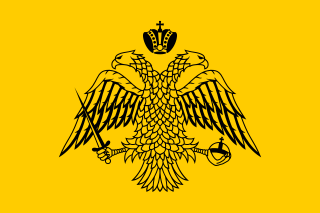
Flag of the Greek Orthodox Church
-

Flag of the Georgian Orthodox Church
-

Flag of the Episcopal Church
-

Flag of the Serbian Orthodox Church
-
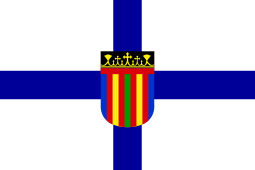
Flag of the Copts - the Christians of Egypt
-
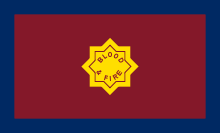
Standard of The Salvation Army
-

Flag of the Albanian Orthodox Church
-

Flag of the Anglican Church of Canada
-

Flag of the Evangelical Church in Germany
-

Flag of the Evangelical Church in Germany (alternative version)
National flags
All the flags based on the Dannebrog, including the Flag of Finland, Flag of the Faroe Islands, Flag of Iceland, Flag of Norway and Flag of Sweden contain a Christian cross, representing Christianity.[15][16] The Union Jack of Great Britain, as well as its descendant flags, "makes reference to three Christian patron saints: the patron saint of England, represented by the red cross of Saint George, the patron saint of Ireland, represented by the red saltire of Saint Patrick, and the patron saint of Scotland, represented by the saltire of Saint Andrew."[17] In addition, the Flag of Greece, as well as the Flag of Switzerland, contain a Christian cross to represent the faith.[18] The "cross on the flag of Dominica represents Christianity while the three colours of which the cross consists stand for the Trinity" and the "coat of arms depicted on the Flag of Slovakia shows a double cross".[19] The Flag of the Dominican Republic also depicts a Bible and a cross.[19] The Flag of Georgia, Flag of Tonga, Flag of Moldova and Flag of Serbia all display a cross representing Christianity.[19] The Flag of Portugal also has Christian symbolism, bearing the five wounds of Christ.[20] The Flag of Vatican City features the keys of St. Peter, which were given to him by Jesus Christ, one or (gold) and one argent (silver), which represent heavenly and earthly power respectively. The flag also features a Christian cross, which surmounts the Papal Tiara.[21][22]
See also
- Black Standard
- Flag of Vatican City
- Christian symbolism
- Cross necklace
- Head of Christ
- Civil religion
References
- 1 2 3 "Resolution". Federal Council Bulletin. Religious Publicity Service of the Federal Council of the Churches of Christ in America. 25-27. 1942.
- 1 2 Fifty-Eighth Annual Session. Order of the Eastern Star. 1932.
Today the Christian Flag is flying over Europe, Asia and Africa, as well as America.
- ↑ "The Christian Flag". Bob Jones University. Archived from the original on Sep 5, 2005. Retrieved 2007-10-18.
The white on the flag represents purity and peace. The blue stands for faithfulness, truth, and sincerity. Red, of course, is the color of sacrifice, in this case calling to mind the blood shed by Christ on Calvary, represented by the cross.
- ↑ The American Lutheran. 22–24. American Lutheran Publicity Bureau. 1939.
- ↑ A Theological Miscellany. Thomas Nelson. 24 March 2005.
The flag is white (for purity and peace), with a blue field (faithfulness, truth, and sincerity) and a red cross (the sacrifice of Christ).
- ↑ "The Christian Flag". Prayer Foundation. Retrieved 2007-10-18.
The flag's most conspicuous symbol is the Christian cross, the most universal symbol for Christianity. The red color represents the blood of Christ and brings to mind his crucifixion. Christians believe that Jesus Christ's death and resurrection is the means God uses to save believers from their sins. The cross and blood have been used since earliest Christianity to symbolize salvation through Jesus; in the words of the Apostle Paul, "And having made peace through the blood of his cross, by him to reconcile all things unto himself;" — Colossians 1:20. The white field draws on symbolism throughout the Bible equating white clothes with purity and forgiveness. People who have been "washed white as snow" in the Bible have been cleansed from their sins (Isaiah 1:18; Psalm 51:2). In conventional vexillology (the study of flags, their history and symbolism), a white flag is linked to surrender, a reference to the Biblical description Jesus' non-violence and surrender to God's will. The symbolism behind the blue canton has been interpreted to represent Heaven, truth, or the Christian ritual of Baptism in water.
- 1 2 "Christian Flag". The Christian Advocate. New York: T. Carlton & J. Porter. 84. 7 January 1909.
Within recent years (1897) a flag has been designed which shall stand as an emblem; (Jesse L. Jones-McKay) which all Christian nations and various denominations may rally in allegiance and devotion. This banner is called the Christian flag. It was originated by Charles C. Overton of Brooklyn, N.Y., whose first thought of it came to him while addressing a Sunday school at a rally day service. The flag is most symbolic. The ground is white, representing peace, purity and innocence. In the upper corner is a blue square, the color of the unclouded sky, emblematic of heave, the home of the Christian; also a symbol of faith and trust. in the center of the blue is the cross, the ensign and chosen symbol of Christianity: the cross is red, typical of Christ's blood. The use of the national flag in Christian churches has become almost universal throughout the world.
- ↑ Coffman, Elesha. "Do you know the history of the Christian flag?". Christianity Today. Retrieved 24 April 2014.
- ↑ "Christian Flag". The Christian Advocate. New York: T. Carlton & J. Porter. 84. 7 January 1909.
Mr. Overton has dedicated his flag to the Christian world, refusing to copyright or patent it. It stands for no creed or denomination, but for Christianity. Every sect of Christ's followers can indorse this flag and it is equally appropriate for all nations. The hymn written by Fanny Crosby is also dedicated to the free use and followers of Christ the world over.
- ↑ The Quiver. Cassell Limited. 1900. p. 380. Retrieved 4 May 2014.
Miss Fanny J. Crosby, the veteran American hymn writer, has dedicated a hymn, called “The Christian Flag,” to the movement, the first verse of which is :— “ The Christian Flag!
- ↑ James R. Pollock, Ph.D., D.D. (23 March 1996). Congratulations to The Christian Flag, Fourth Edition.
- ↑ Fr. Brian Daniels. "Flags in Church" (in Roann and Indiana).
- 1 2 3 "Ask the expert", Christianity Today, Jul 13, 2001
|contribution=ignored (help). - ↑ Christian Flag Facts, Montney.
- ↑ Temperman, Jeroen (2010). State-Religion Relationships and Human Rights Law: Towards a Right to Religiously Neutral Governance. Brill Academic. p. 88. ISBN 9789004181489.
Many predominantly Christian states show a cross, symbolising Christainity, on their national flag. Scandinavian crosses or Nordic crosses on the flags of the Nordic countries–Denmark, Finland, Iceland, Norway and Sweden–also represent Christianity.
- ↑ Evans, Andrew (2008). Iceland. Bradt Travel Guides. p. 27. ISBN 9781841622156.
Legend states that a red cloth with the white cross simply fell from the sky in the middle of the 13th-century Battle of Valdemar, after which the Danes were victorious. As a badge of divine right, Denmark flew its cross in the other Scandinavian countries it ruled and as each nation gained independence, they incorporated the Christian symbol.
- ↑ Temperman, Jeroen (2010). State-Religion Relationships and Human Rights Law: Towards a Right to Religiously Neutral Governance. Brill Academic Publishers. p. 88. ISBN 9789004181489.
Many predominantly Christian states show a cross, symbolising Christianity, on their national flag. The Union flag of the United Kingdom of Great Britain and Northern-Ireland makes reference to three Christian patron saints: the patron saint of England, represented by the red cross of Saint George, the patron saint of Ireland, represented by the red saltire of Saint Patrick, and the patron saint of Scotland, represented by the saltire of Saint Andrew.
- ↑ Foley, Carol A. (1 January 1996). The Australian Flag. Federation Press. p. 10. ISBN 9781862871885.
The Christian cross, for instance, is one of the oldest and most widely used symbols in the world, and many European countries, such as the United Kingdom, Norway, Sweden, Finland, Denmark, Iceland, Greece and Switzerland, adopted and currently retain the Christian cross on their national flags.
- 1 2 3 Temperman, Jeroen (2010). State-Religion Relationships and Human Rights Law: Towards a Right to Religiously Neutral Governance. Brill Academic. p. 88. ISBN 9789004181489.
The cross on the flag of Dominica represents Christianity while the three colours of which the cross consists stand for the Trinity. The coat of arms depicted on the flag of Slovakia shows a double cross. The flag of the Dominican Republic represents Christianity while the three colours of which the cross consists stand for the Tinity. The coat of arms depicted on the flag of Slovakia shows a double cross. The flag of the Dominican Republic shows the words "God, Fatherland, Liberty", an opened bible and a cross (depicted in the coat of arms which is represented in the centre). The 'five-cross-flag' of George shows four small crosses and a large St. George's Cross, referring to the patron saint of Georgia (the national flag of England shows the St. George's Cross as well). The white cross on the flag of Greece symbolizes Greek Orthodoxy. The flag of Moldova shows its coat of arms in the centre: an eagle with a Christian Orthodox cross in its beak. The coat of arms of Serbia, as depicted on the national flag, also shows an Orthodox cross.
- ↑ McCandless, Byron; Grosvenor, Gilbert Hovey (1917). Flags of the World. National Geographic Society. p. 403.
The Portugal man-of-war (1182) and merchant flags (1183 and 1184) bore the same distinguishing features— five shields with the five circles representing the five wounds of Christ, the castles surrounding the inner shields and the armillary sphere, reminiscent of that nation's maritime prowess in the sixteenth century, 200 years ago, as they do now.
- ↑ "Holy See Press Office". Vatican.va. Archived from the original on 2015-09-18.
- ↑ "Holy See Press Office - Papal Tiara". Vatican.va. Archived from the original on 2013-03-07.
Further reading
- Balmer, Randall Herbert (2002), Encyclopedia of Evangelicalism, Baylor University Press, p. 134.
- Land, Richard (2011), The Divided States of America?: What Liberals and Conservatives Get Wrong about Faith and Politics (revised ed.), Thomas Nelson, p. 41.
- Marvin, C (1996), "Blood sacrifice and the nation: Revisiting civil religion", Journal of the American Academy of Religion.
External links
- Coffman, Elesha (13 July 2001), "Christian History & Biography", Christianity Today
- History & Symbolism of the Christian Flag, Society of the Christian Flag
- "The Christian Flag Hymn", The Christian Flag, Cyber Hymnal
- Sidwell, Mark (18 December 1998), "The Christian Flag", Fundamentalism File Research Report, BJU
- "Christian Flag", Flags of the World


